+ Open data
Open data
- Basic information
Basic information
| Entry | Database: PDB / ID: 7kk2 | ||||||
|---|---|---|---|---|---|---|---|
| Title | Structure of the catalytic domain of PARP1 | ||||||
 Components Components | Poly [ADP-ribose] polymerase 1 | ||||||
 Keywords Keywords | TRANSFERASE / PARP1 | ||||||
| Function / homology |  Function and homology information Function and homology informationNAD+-histone H2BS6 serine ADP-ribosyltransferase activity / NAD+-histone H3S10 serine ADP-ribosyltransferase activity / NAD+-histone H2BE35 glutamate ADP-ribosyltransferase activity / positive regulation of myofibroblast differentiation / negative regulation of ATP biosynthetic process / NAD+-protein-tyrosine ADP-ribosyltransferase activity / NAD+-protein-histidine ADP-ribosyltransferase activity / regulation of base-excision repair / positive regulation of single strand break repair / regulation of circadian sleep/wake cycle, non-REM sleep ...NAD+-histone H2BS6 serine ADP-ribosyltransferase activity / NAD+-histone H3S10 serine ADP-ribosyltransferase activity / NAD+-histone H2BE35 glutamate ADP-ribosyltransferase activity / positive regulation of myofibroblast differentiation / negative regulation of ATP biosynthetic process / NAD+-protein-tyrosine ADP-ribosyltransferase activity / NAD+-protein-histidine ADP-ribosyltransferase activity / regulation of base-excision repair / positive regulation of single strand break repair / regulation of circadian sleep/wake cycle, non-REM sleep / vRNA Synthesis / carbohydrate biosynthetic process / NAD+-protein-serine ADP-ribosyltransferase activity / negative regulation of adipose tissue development / NAD DNA ADP-ribosyltransferase activity / DNA ADP-ribosylation / mitochondrial DNA metabolic process / regulation of oxidative stress-induced neuron intrinsic apoptotic signaling pathway / replication fork reversal / ATP generation from poly-ADP-D-ribose / positive regulation of necroptotic process / transcription regulator activator activity / response to aldosterone / HDR through MMEJ (alt-NHEJ) / positive regulation of DNA-templated transcription, elongation / NAD+ ADP-ribosyltransferase / signal transduction involved in regulation of gene expression / protein auto-ADP-ribosylation / negative regulation of telomere maintenance via telomere lengthening / mitochondrial DNA repair / NAD+-protein-aspartate ADP-ribosyltransferase activity / protein poly-ADP-ribosylation / positive regulation of intracellular estrogen receptor signaling pathway / negative regulation of cGAS/STING signaling pathway / NAD+-protein-glutamate ADP-ribosyltransferase activity / positive regulation of cardiac muscle hypertrophy / positive regulation of mitochondrial depolarization / cellular response to zinc ion / NAD+-protein mono-ADP-ribosyltransferase activity / nuclear replication fork / decidualization / protein autoprocessing / R-SMAD binding / macrophage differentiation / site of DNA damage / Transferases; Glycosyltransferases; Pentosyltransferases / negative regulation of transcription elongation by RNA polymerase II / POLB-Dependent Long Patch Base Excision Repair / positive regulation of SMAD protein signal transduction / NAD+ poly-ADP-ribosyltransferase activity / SUMOylation of DNA damage response and repair proteins / positive regulation of double-strand break repair via homologous recombination / nucleosome binding / protein localization to chromatin / nucleotidyltransferase activity / telomere maintenance / transforming growth factor beta receptor signaling pathway / negative regulation of innate immune response / nuclear estrogen receptor binding / response to gamma radiation / mitochondrion organization / Downregulation of SMAD2/3:SMAD4 transcriptional activity / enzyme activator activity / protein-DNA complex / cellular response to nerve growth factor stimulus / DNA Damage Recognition in GG-NER / protein modification process / Dual Incision in GG-NER / positive regulation of protein localization to nucleus / histone deacetylase binding / Formation of Incision Complex in GG-NER / cellular response to insulin stimulus / cellular response to amyloid-beta / NAD binding / cellular response to UV / nuclear envelope / double-strand break repair / regulation of protein localization / site of double-strand break / cellular response to oxidative stress / transcription regulator complex / damaged DNA binding / RNA polymerase II-specific DNA-binding transcription factor binding / transcription by RNA polymerase II / chromosome, telomeric region / positive regulation of canonical NF-kappaB signal transduction / nuclear body / innate immune response / DNA repair / negative regulation of DNA-templated transcription / apoptotic process / DNA damage response / ubiquitin protein ligase binding / chromatin binding / protein kinase binding / chromatin / nucleolus / enzyme binding / negative regulation of transcription by RNA polymerase II / protein homodimerization activity Similarity search - Function | ||||||
| Biological species |  Homo sapiens (human) Homo sapiens (human) | ||||||
| Method |  X-RAY DIFFRACTION / X-RAY DIFFRACTION /  SYNCHROTRON / SYNCHROTRON /  MOLECULAR REPLACEMENT / Resolution: 1.695 Å MOLECULAR REPLACEMENT / Resolution: 1.695 Å | ||||||
 Authors Authors | Gajiwala, K.S. / Ryan, K. | ||||||
 Citation Citation |  Journal: J.Biol.Chem. / Year: 2021 Journal: J.Biol.Chem. / Year: 2021Title: Dissecting the molecular determinants of clinical PARP1 inhibitor selectivity for tankyrase1. Authors: Ryan, K. / Bolanos, B. / Smith, M. / Palde, P.B. / Cuenca, P.D. / VanArsdale, T.L. / Niessen, S. / Zhang, L. / Behenna, D. / Ornelas, M.A. / Tran, K.T. / Kaiser, S. / Lum, L. / Stewart, A. / Gajiwala, K.S. | ||||||
| History |
|
- Structure visualization
Structure visualization
| Structure viewer | Molecule:  Molmil Molmil Jmol/JSmol Jmol/JSmol |
|---|
- Downloads & links
Downloads & links
- Download
Download
| PDBx/mmCIF format |  7kk2.cif.gz 7kk2.cif.gz | 160.7 KB | Display |  PDBx/mmCIF format PDBx/mmCIF format |
|---|---|---|---|---|
| PDB format |  pdb7kk2.ent.gz pdb7kk2.ent.gz | 124.8 KB | Display |  PDB format PDB format |
| PDBx/mmJSON format |  7kk2.json.gz 7kk2.json.gz | Tree view |  PDBx/mmJSON format PDBx/mmJSON format | |
| Others |  Other downloads Other downloads |
-Validation report
| Summary document |  7kk2_validation.pdf.gz 7kk2_validation.pdf.gz | 2.7 MB | Display |  wwPDB validaton report wwPDB validaton report |
|---|---|---|---|---|
| Full document |  7kk2_full_validation.pdf.gz 7kk2_full_validation.pdf.gz | 2.7 MB | Display | |
| Data in XML |  7kk2_validation.xml.gz 7kk2_validation.xml.gz | 30.9 KB | Display | |
| Data in CIF |  7kk2_validation.cif.gz 7kk2_validation.cif.gz | 45.7 KB | Display | |
| Arichive directory |  https://data.pdbj.org/pub/pdb/validation_reports/kk/7kk2 https://data.pdbj.org/pub/pdb/validation_reports/kk/7kk2 ftp://data.pdbj.org/pub/pdb/validation_reports/kk/7kk2 ftp://data.pdbj.org/pub/pdb/validation_reports/kk/7kk2 | HTTPS FTP |
-Related structure data
| Related structure data |  7kk3C  7kk4C  7kk5C 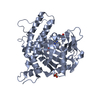 7kk6C  7kkmC  7kknC  7kkoC  7kkpC  7kkqC  5ws1S S: Starting model for refinement C: citing same article ( |
|---|---|
| Similar structure data |
- Links
Links
- Assembly
Assembly
| Deposited unit | 
| ||||||||
|---|---|---|---|---|---|---|---|---|---|
| 1 | 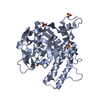
| ||||||||
| 2 | 
| ||||||||
| Unit cell |
|
- Components
Components
| #1: Protein | Mass: 39340.988 Da / Num. of mol.: 2 Source method: isolated from a genetically manipulated source Source: (gene. exp.)  Homo sapiens (human) / Gene: PARP1, ADPRT, PPOL / Production host: Homo sapiens (human) / Gene: PARP1, ADPRT, PPOL / Production host:  References: UniProt: P09874, NAD+ ADP-ribosyltransferase, Transferases; Glycosyltransferases; Pentosyltransferases #2: Chemical | ChemComp-SO4 / #3: Water | ChemComp-HOH / | Has ligand of interest | Y | |
|---|
-Experimental details
-Experiment
| Experiment | Method:  X-RAY DIFFRACTION / Number of used crystals: 1 X-RAY DIFFRACTION / Number of used crystals: 1 |
|---|
- Sample preparation
Sample preparation
| Crystal | Density Matthews: 2.28 Å3/Da / Density % sol: 46.02 % |
|---|---|
| Crystal grow | Temperature: 277 K / Method: vapor diffusion Details: Buffer: 0.1 M bicine (pH 9.00) Precipitant: 2.4 M Ammonium sulfate |
-Data collection
| Diffraction | Mean temperature: 98 K / Serial crystal experiment: N |
|---|---|
| Diffraction source | Source:  SYNCHROTRON / Site: SYNCHROTRON / Site:  APS APS  / Beamline: 17-ID / Wavelength: 1 Å / Beamline: 17-ID / Wavelength: 1 Å |
| Detector | Type: DECTRIS PILATUS3 6M / Detector: PIXEL / Date: Nov 4, 2019 |
| Radiation | Protocol: SINGLE WAVELENGTH / Monochromatic (M) / Laue (L): M / Scattering type: x-ray |
| Radiation wavelength | Wavelength: 1 Å / Relative weight: 1 |
| Reflection | Resolution: 1.713→79.9 Å / Num. obs: 58284 / % possible obs: 89.9 % / Redundancy: 6.1 % / CC1/2: 0.998 / Net I/σ(I): 13.1 |
| Reflection shell | Resolution: 1.713→1.848 Å / Num. unique obs: 2914 / CC1/2: 0.5 |
- Processing
Processing
| Software |
| ||||||||||||||||||||||||||||||||||||||||||||||||||||||||||||
|---|---|---|---|---|---|---|---|---|---|---|---|---|---|---|---|---|---|---|---|---|---|---|---|---|---|---|---|---|---|---|---|---|---|---|---|---|---|---|---|---|---|---|---|---|---|---|---|---|---|---|---|---|---|---|---|---|---|---|---|---|---|
| Refinement | Method to determine structure:  MOLECULAR REPLACEMENT MOLECULAR REPLACEMENTStarting model: 5WS1 Resolution: 1.695→25 Å / Cor.coef. Fo:Fc: 0.946 / Cor.coef. Fo:Fc free: 0.929 / SU R Cruickshank DPI: 0.162 / Cross valid method: THROUGHOUT / SU R Blow DPI: 0.171 / SU Rfree Blow DPI: 0.148 / SU Rfree Cruickshank DPI: 0.145
| ||||||||||||||||||||||||||||||||||||||||||||||||||||||||||||
| Displacement parameters | Biso mean: 31.8 Å2
| ||||||||||||||||||||||||||||||||||||||||||||||||||||||||||||
| Refine analyze | Luzzati coordinate error obs: 0.27 Å | ||||||||||||||||||||||||||||||||||||||||||||||||||||||||||||
| Refinement step | Cycle: LAST / Resolution: 1.695→25 Å
| ||||||||||||||||||||||||||||||||||||||||||||||||||||||||||||
| Refine LS restraints |
| ||||||||||||||||||||||||||||||||||||||||||||||||||||||||||||
| LS refinement shell | Resolution: 1.7→2 Å
|
 Movie
Movie Controller
Controller



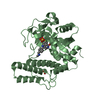
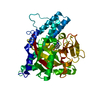
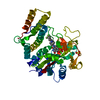

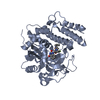
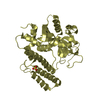

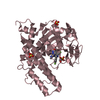


 PDBj
PDBj








